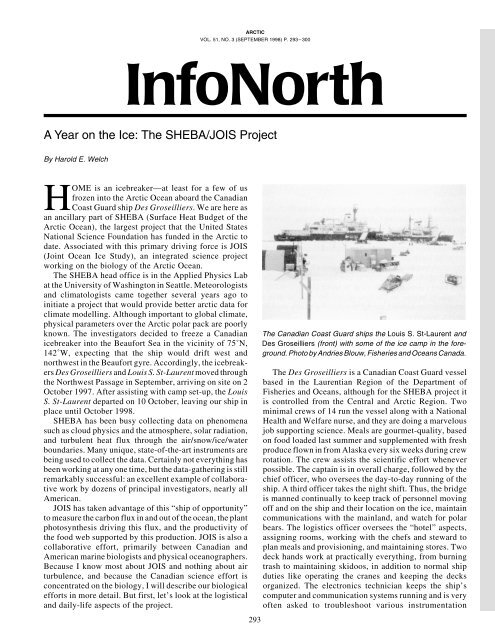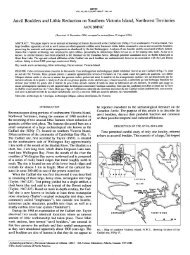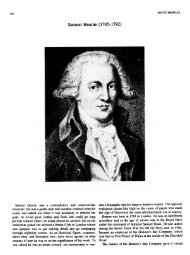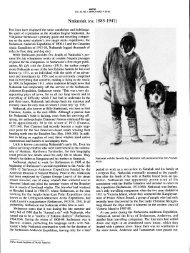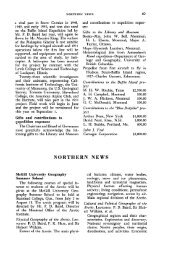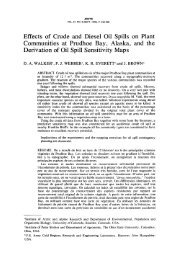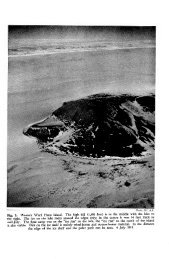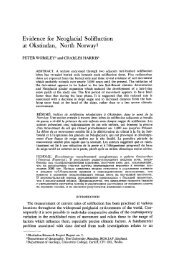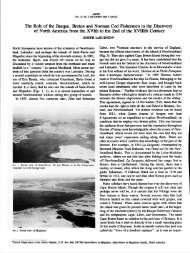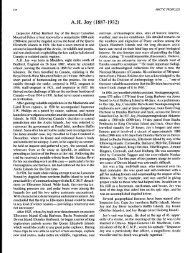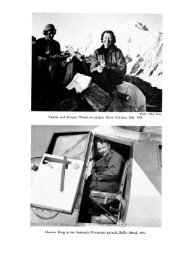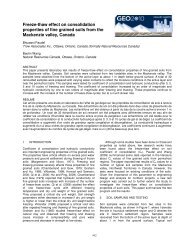A Year on the Ice: The SHEBA/JOIS Project - arctic
A Year on the Ice: The SHEBA/JOIS Project - arctic
A Year on the Ice: The SHEBA/JOIS Project - arctic
Create successful ePaper yourself
Turn your PDF publications into a flip-book with our unique Google optimized e-Paper software.
ARCTIC<br />
VOL. 51, NO. 3 (SEPTEMBER 1998) P. 293– 300<br />
InfoNorth<br />
A <str<strong>on</strong>g>Year</str<strong>on</strong>g> <strong>on</strong> <strong>the</strong> <strong>Ice</strong>: <strong>The</strong> <strong>SHEBA</strong>/<strong>JOIS</strong> <strong>Project</strong><br />
By Harold E. Welch<br />
HOME is an icebreaker—at least for a few of us<br />
frozen into <strong>the</strong> Arctic Ocean aboard <strong>the</strong> Canadian<br />
Coast Guard ship Des Groseilliers. We are here as<br />
an ancillary part of <strong>SHEBA</strong> (Surface Heat Budget of <strong>the</strong><br />
Arctic Ocean), <strong>the</strong> largest project that <strong>the</strong> United States<br />
Nati<strong>on</strong>al Science Foundati<strong>on</strong> has funded in <strong>the</strong> Arctic to<br />
date. Associated with this primary driving force is <strong>JOIS</strong><br />
(Joint Ocean <strong>Ice</strong> Study), an integrated science project<br />
working <strong>on</strong> <strong>the</strong> biology of <strong>the</strong> Arctic Ocean.<br />
<strong>The</strong> <strong>SHEBA</strong> head office is in <strong>the</strong> Applied Physics Lab<br />
at <strong>the</strong> University of Washingt<strong>on</strong> in Seattle. Meteorologists<br />
and climatologists came toge<strong>the</strong>r several years ago to<br />
initiate a project that would provide better <strong>arctic</strong> data for<br />
climate modelling. Although important to global climate,<br />
physical parameters over <strong>the</strong> Arctic polar pack are poorly<br />
known. <strong>The</strong> investigators decided to freeze a Canadian<br />
icebreaker into <strong>the</strong> Beaufort Sea in <strong>the</strong> vicinity of 75˚N,<br />
142˚W, expecting that <strong>the</strong> ship would drift west and<br />
northwest in <strong>the</strong> Beaufort gyre. Accordingly, <strong>the</strong> icebreakers<br />
Des Groseilliers and Louis S. St-Laurent moved through<br />
<strong>the</strong> Northwest Passage in September, arriving <strong>on</strong> site <strong>on</strong> 2<br />
October 1997. After assisting with camp set-up, <strong>the</strong> Louis<br />
S. St-Laurent departed <strong>on</strong> 10 October, leaving our ship in<br />
place until October 1998.<br />
<strong>SHEBA</strong> has been busy collecting data <strong>on</strong> phenomena<br />
such as cloud physics and <strong>the</strong> atmosphere, solar radiati<strong>on</strong>,<br />
and turbulent heat flux through <strong>the</strong> air/snow/ice/water<br />
boundaries. Many unique, state-of-<strong>the</strong>-art instruments are<br />
being used to collect <strong>the</strong> data. Certainly not everything has<br />
been working at any <strong>on</strong>e time, but <strong>the</strong> data-ga<strong>the</strong>ring is still<br />
remarkably successful: an excellent example of collaborative<br />
work by dozens of principal investigators, nearly all<br />
American.<br />
<strong>JOIS</strong> has taken advantage of this “ship of opportunity”<br />
to measure <strong>the</strong> carb<strong>on</strong> flux in and out of <strong>the</strong> ocean, <strong>the</strong> plant<br />
photosyn<strong>the</strong>sis driving this flux, and <strong>the</strong> productivity of<br />
<strong>the</strong> food web supported by this producti<strong>on</strong>. <strong>JOIS</strong> is also a<br />
collaborative effort, primarily between Canadian and<br />
American marine biologists and physical oceanographers.<br />
Because I know most about <strong>JOIS</strong> and nothing about air<br />
turbulence, and because <strong>the</strong> Canadian science effort is<br />
c<strong>on</strong>centrated <strong>on</strong> <strong>the</strong> biology, I will describe our biological<br />
efforts in more detail. But first, let’s look at <strong>the</strong> logistical<br />
and daily-life aspects of <strong>the</strong> project.<br />
293<br />
<strong>The</strong> Canadian Coast Guard ships <strong>the</strong> Louis S. St-Laurent and<br />
Des Groseilliers (fr<strong>on</strong>t) with some of <strong>the</strong> ice camp in <strong>the</strong> foreground.<br />
Photo by Andries Blouw, Fisheries and Oceans Canada.<br />
<strong>The</strong> Des Groseilliers is a Canadian Coast Guard vessel<br />
based in <strong>the</strong> Laurentian Regi<strong>on</strong> of <strong>the</strong> Department of<br />
Fisheries and Oceans, although for <strong>the</strong> <strong>SHEBA</strong> project it<br />
is c<strong>on</strong>trolled from <strong>the</strong> Central and Arctic Regi<strong>on</strong>. Two<br />
minimal crews of 14 run <strong>the</strong> vessel al<strong>on</strong>g with a Nati<strong>on</strong>al<br />
Health and Welfare nurse, and <strong>the</strong>y are doing a marvelous<br />
job supporting science. Meals are gourmet-quality, based<br />
<strong>on</strong> food loaded last summer and supplemented with fresh<br />
produce flown in from Alaska every six weeks during crew<br />
rotati<strong>on</strong>. <strong>The</strong> crew assists <strong>the</strong> scientific effort whenever<br />
possible. <strong>The</strong> captain is in overall charge, followed by <strong>the</strong><br />
chief officer, who oversees <strong>the</strong> day-to-day running of <strong>the</strong><br />
ship. A third officer takes <strong>the</strong> night shift. Thus, <strong>the</strong> bridge<br />
is manned c<strong>on</strong>tinually to keep track of pers<strong>on</strong>nel moving<br />
off and <strong>on</strong> <strong>the</strong> ship and <strong>the</strong>ir locati<strong>on</strong> <strong>on</strong> <strong>the</strong> ice, maintain<br />
communicati<strong>on</strong>s with <strong>the</strong> mainland, and watch for polar<br />
bears. <strong>The</strong> logistics officer oversees <strong>the</strong> “hotel” aspects,<br />
assigning rooms, working with <strong>the</strong> chefs and steward to<br />
plan meals and provisi<strong>on</strong>ing, and maintaining stores. Two<br />
deck hands work at practically everything, from burning<br />
trash to maintaining skidoos, in additi<strong>on</strong> to normal ship<br />
duties like operating <strong>the</strong> cranes and keeping <strong>the</strong> decks<br />
organized. <strong>The</strong> electr<strong>on</strong>ics technician keeps <strong>the</strong> ship’s<br />
computer and communicati<strong>on</strong> systems running and is very<br />
often asked to troubleshoot various instrumentati<strong>on</strong>
294 • H.E. WELCH<br />
<strong>The</strong> ship’s crew and scientific pers<strong>on</strong>nel in fr<strong>on</strong>t of <strong>the</strong> CCGS Des<br />
Groseilliers, autumn 1997. Photo by Andries Blouw, Fisheries<br />
and Oceans Canada.<br />
problems for <strong>the</strong> scientists. Two engineers and two oilers<br />
keep <strong>the</strong> electrical and mechanical systems operati<strong>on</strong>al.<br />
<strong>The</strong> engineers are skilled machinists, knowledgeable about<br />
everything from refrigerati<strong>on</strong> to electrical systems and<br />
<strong>the</strong>y have a good machine shop <strong>on</strong> board. <strong>The</strong>y have been<br />
especially helpful to <strong>the</strong> biologists, who seem to have a<br />
never-ending demand for equipment fabricati<strong>on</strong>, modificati<strong>on</strong>,<br />
and repair.<br />
As a floating hotel, <strong>the</strong> Des Groseilliers is great: <strong>the</strong><br />
<strong>on</strong>ly thing missing is abundant lab space <strong>on</strong> board a ship<br />
not designed as a science-support vessel. <strong>The</strong> <strong>SHEBA</strong><br />
project office also provides a three-pers<strong>on</strong> logistical support<br />
team <strong>on</strong> site. <strong>The</strong>y maintain <strong>the</strong> runway with a D4<br />
Caterpillar tractor that was loaded aboard <strong>the</strong> Louis last<br />
fall in Resolute (courtesy of <strong>the</strong> Polar C<strong>on</strong>tinental Shelf<br />
<strong>Project</strong>), keep science huts, etc. <strong>on</strong> <strong>the</strong> ice operati<strong>on</strong>al, and<br />
organize <strong>the</strong> supply flights. Because of this tremendous<br />
support infrastructure, science pers<strong>on</strong>nel can devote all<br />
<strong>the</strong>ir time and energy to data acquisiti<strong>on</strong>, maximizing <strong>the</strong>ir<br />
efficiency.<br />
We are often asked what we do with our spare time, and<br />
our usual reply is “What spare time?” Most of us science<br />
types welcome <strong>the</strong> opportunity to work every day and most<br />
evenings at what we do best. <strong>The</strong> bar is open three nights<br />
a week for a couple of hours and is well-attended as a<br />
source of relaxati<strong>on</strong> and social interacti<strong>on</strong>. <strong>The</strong> exercise<br />
room is popular with some, although use has decreased<br />
since <strong>the</strong> motor burned out <strong>on</strong> <strong>the</strong> treadmill. Movies are<br />
played <strong>on</strong> <strong>the</strong> ship’s network every night, and a variety of<br />
music is piped over <strong>the</strong> public address system. A couple of<br />
hundred paperbacks are available and well-read. <strong>The</strong>re<br />
must be fifty or more computers <strong>on</strong> board and <strong>on</strong> <strong>the</strong> ice.<br />
<strong>The</strong> officers’ lounge and dining room have been c<strong>on</strong>verted<br />
to computer rooms and at any time of <strong>the</strong> day, <strong>the</strong>re are<br />
people staring at <strong>the</strong> screens, downloading and analyzing<br />
<strong>the</strong>ir latest data.<br />
Back east, at <strong>the</strong> beginning of <strong>the</strong> drift, <strong>the</strong> ship received<br />
both <strong>the</strong> Msat and Inmarsat satellites, and <strong>the</strong> former was<br />
<strong>The</strong> Blue Bio lab being moved into positi<strong>on</strong> <strong>on</strong> <strong>the</strong> ice. Photo by<br />
Andries Blouw, Fisheries and Oceans Canada.<br />
relatively cheap at <strong>on</strong>e dollar per minute. Now, however,<br />
we are in range <strong>on</strong>ly of <strong>the</strong> Inmarsat, at a much higher rate,<br />
so ph<strong>on</strong>e calls, at least for pers<strong>on</strong>al use, are avoided as<br />
much as possible. E-mail, which comes in and out twice<br />
daily, is <strong>the</strong> primary means of communicati<strong>on</strong> with <strong>the</strong><br />
south. My wife Cathy and I have been <strong>on</strong> board since<br />
August and will remain until next October, so e-mail is <strong>the</strong><br />
social high point of our day, a marvelous and inexpensive<br />
way to keep up c<strong>on</strong>tacts with family, friends, and colleagues,<br />
all of whom now fall into two categories: e-mail<br />
(= regular corresp<strong>on</strong>dence) and snail mail. We didn’t get<br />
our Christmas presents and cards until February or March.<br />
Now <strong>on</strong> to <strong>the</strong> science. We biologists have several labs<br />
<strong>on</strong> <strong>the</strong> ice about 100 m from <strong>the</strong> ship. Three are modified<br />
shipping c<strong>on</strong>tainers painted bright blue, so <strong>the</strong> whole thing<br />
is called Blue Bio. One 2.5 × 5 m c<strong>on</strong>tainer holds a large<br />
electric-hydraulic winch spooled with 4 km of kevlar cable<br />
deployed through a 1.25 × 1.25 m hole in <strong>the</strong> floor. With<br />
that cable, we drop salinity profilers, 1 m 2 plankt<strong>on</strong> nets,<br />
water sampling bottles, and even baited l<strong>on</strong>g-lines. Nestled<br />
against <strong>the</strong> winch room is Big Blue, a 12 m c<strong>on</strong>tainer<br />
housing water baths with pumped fresh seawater and<br />
various instruments. A small c<strong>on</strong>tainer nearby serves as a<br />
photosyn<strong>the</strong>sis lab for radioactive carb<strong>on</strong> tracer work. A<br />
Parcol hut for cold storage completes <strong>the</strong> setup. Everything<br />
is powered by two 440 V electrical lines from <strong>the</strong><br />
ship.<br />
Our efforts to quantify <strong>the</strong> productivity and its c<strong>on</strong>trolling<br />
factors start with light transmissi<strong>on</strong> through ice and<br />
snow, because that is what drives <strong>the</strong> marine system. A<br />
critical advantage for us is <strong>the</strong> opportunity to extrapolate<br />
our data over a wide area of <strong>the</strong> Arctic Ocean using <strong>the</strong><br />
informati<strong>on</strong> provided by our <strong>SHEBA</strong> colleagues. We <strong>the</strong>n<br />
m<strong>on</strong>itor <strong>the</strong> biomass of microalgae floating in <strong>the</strong> water<br />
column (phytoplankt<strong>on</strong>) and growing <strong>on</strong> <strong>the</strong> underside of<br />
<strong>the</strong> ice (ice algae), and measure growth rates as a functi<strong>on</strong><br />
of light flux in lab experiments, using radioactive carb<strong>on</strong><br />
as a tracer label. Micr<strong>on</strong>utrients (N, P, Si) are also potential<br />
c<strong>on</strong>trolling factors for plant growth, so every eighth
Buster Welch being readied for a dive through <strong>the</strong> Blue Bio<br />
Hydrohole. Photo by Andries Blouw, Fisheries and Oceans<br />
Canada.<br />
day is “chem day,” when we measure nutrient c<strong>on</strong>centrati<strong>on</strong>s,<br />
oxygen, organic carb<strong>on</strong>, and chlorophyll at 21 depths<br />
down to 240 m. Chemical measurements are followed by<br />
a salinity/temperature profile because <strong>the</strong> water mass structure<br />
(layering) has a lot to do with nutrient availability, as<br />
well as being of interest to physical oceanographers working<br />
<strong>on</strong> <strong>the</strong> project. <strong>The</strong> fate of organic carb<strong>on</strong> in <strong>the</strong> water<br />
column begins with <strong>the</strong> “microbial loop” (all <strong>the</strong> critters<br />
too small to see), which we study with a variety of tracer,<br />
oxygen c<strong>on</strong>sumpti<strong>on</strong>, and counting experiments. Next<br />
come <strong>the</strong> visible animals living in <strong>the</strong> water column<br />
(zooplankt<strong>on</strong>). We quantify <strong>the</strong> zooplankt<strong>on</strong> from top to<br />
bottom with net hauls, measure <strong>the</strong>ir respirati<strong>on</strong> and growth<br />
rates, and estimate <strong>the</strong>ir energy demand and productivity.<br />
In additi<strong>on</strong> to ice algae, fingernail-sized crustacea called<br />
amphipods live against <strong>the</strong> ice surface, as well as <strong>arctic</strong><br />
cod, which spend most of <strong>the</strong>ir time hiding in crevices in<br />
<strong>the</strong> ice keels beneath pressure ridges (<strong>the</strong>y also occur in <strong>the</strong><br />
water column). To quantify ice algae, we use a sub-ice<br />
sucti<strong>on</strong> device <strong>on</strong> an arm (familiarily called <strong>the</strong> Drill<br />
A YEAR ON THE ICE: THE <strong>SHEBA</strong>/<strong>JOIS</strong> PROJECT • 295<br />
Sucker) to reach under <strong>the</strong> ice, drill a hole of known area,<br />
and suck <strong>the</strong> sample back to <strong>the</strong> surface for subsequent<br />
analysis. For amphipods and ice algae <strong>on</strong> pressure ridges,<br />
we use divers and a system that returns exhaust air to <strong>the</strong><br />
surface to avoid disturbance by bubbles, and permits good<br />
communicati<strong>on</strong> between divers and surface. For amphipods,<br />
<strong>the</strong> surface support team notifies <strong>the</strong> diver when ready; <strong>the</strong><br />
diver vacuums a known sub-ice area with a vacuum hose;<br />
and <strong>the</strong> sample is collected at <strong>the</strong> surface—a procedure<br />
that sounds deceptively simple. Murphy does indeed lurk<br />
beneath <strong>the</strong> ship, and hoses freeze, pumps fail, flasks<br />
break, regulators freeze, <strong>the</strong> litany goes <strong>on</strong> and <strong>on</strong>. But<br />
<strong>the</strong>n, no <strong>on</strong>e said Arctic field work was easy!<br />
Of course it is <strong>the</strong> top predators that are of most interest<br />
to <strong>the</strong> average pers<strong>on</strong>: in this case, <strong>the</strong>y are ringed seals,<br />
permanent pack ice residents, who feed <strong>on</strong> <strong>arctic</strong> cod and<br />
amphipods, and in turn support polar bears. Unfortunately,<br />
<strong>the</strong> helicopter that was to support <strong>the</strong> bear and ringed seal<br />
work this spring was cancelled, and with it went our<br />
chance to quantify producti<strong>on</strong> of seals and bears, <strong>the</strong><br />
fourth and fifth levels in <strong>the</strong> food chain. We have had about<br />
ten bears near <strong>the</strong> ship since October and have seen a few<br />
seals in <strong>the</strong> leads. Last week a large bear excavated a<br />
ringed seal birth lair in sight of people watching from <strong>the</strong><br />
bridge, but it did not catch <strong>the</strong> young seal. This water is less<br />
productive than <strong>the</strong> seas<strong>on</strong>al ice z<strong>on</strong>e around Huds<strong>on</strong> Bay<br />
and <strong>the</strong> islands, so seals and bears are less abundant than<br />
in those areas.<br />
Associated with this work, sediment traps have been<br />
suspended from <strong>the</strong> ice to collect particles falling out of <strong>the</strong><br />
upper ocean. This will give us <strong>on</strong>e measure of <strong>the</strong> flux of<br />
carb<strong>on</strong>, nutrients, and c<strong>on</strong>taminants to <strong>the</strong> deep ocean. We<br />
also measure c<strong>on</strong>taminants coming in with air, accumulating<br />
<strong>on</strong> <strong>the</strong> snow, and running into <strong>the</strong> sea with spring melt,<br />
as well as <strong>the</strong>ir c<strong>on</strong>centrati<strong>on</strong> changes up <strong>the</strong> food chain.<br />
Stable isotopes of carb<strong>on</strong> and nitrogen give us informati<strong>on</strong><br />
<strong>on</strong> <strong>the</strong> trophic level (or place in <strong>the</strong> food chain) for each<br />
species, even though we may not know precisely what a<br />
given species eats. This trophic level estimate closely<br />
parallels <strong>the</strong> c<strong>on</strong>centrati<strong>on</strong> of biomagnified c<strong>on</strong>taminants,<br />
such as PCB and mercury. <strong>The</strong> well-known “<strong>arctic</strong> haze”<br />
phenomen<strong>on</strong> results from aerosol transport of c<strong>on</strong>taminants<br />
from Eurasia over <strong>the</strong> polar basin into <strong>the</strong> Canadian<br />
Arctic, and here we should be right in its path. We also<br />
collect snow samples to measure <strong>the</strong> chemical changes and<br />
fracti<strong>on</strong>ati<strong>on</strong> that occur as <strong>the</strong> return of <strong>the</strong> sun in late<br />
winter brings complex oz<strong>on</strong>e and o<strong>the</strong>r chemistry. Measurements<br />
of O 18 trace <strong>the</strong> origin and fate of rain, snow, ice,<br />
and meltwater in <strong>the</strong> upper ocean, and also support <strong>the</strong><br />
c<strong>on</strong>taminant studies.<br />
So what have we found so far? <strong>The</strong>re is always <strong>the</strong><br />
public percepti<strong>on</strong> <strong>on</strong> projects such as this that we must<br />
have made some astounding breakthrough, made some<br />
observati<strong>on</strong> that allows us to say something like “Yes,<br />
global warming has d<strong>on</strong>e thus and such to <strong>the</strong> <strong>arctic</strong> marine<br />
food web.” But science isn’t usually that simple, and <strong>JOIS</strong><br />
is no excepti<strong>on</strong>. We are acquiring <strong>the</strong> best set of data <strong>on</strong> <strong>the</strong>
296 • H.E. WELCH<br />
Dr. Harold “Buster” Welch of <strong>the</strong> Freshwater Institute, Winnipeg,<br />
Manitoba. Photo by Andries Blouw, Fisheries and Oceans<br />
Canada.<br />
productivity of <strong>the</strong> Arctic Ocean made to date, from which<br />
we can measure changes, extrapolate, and pretty much<br />
speculate at will (was it Mark Twain who said that science<br />
was w<strong>on</strong>derful—where else could so little data generate so<br />
much speculati<strong>on</strong>?). But <strong>the</strong>re have been some interesting<br />
preliminary results.<br />
First, <strong>the</strong> <strong>on</strong>ly previous estimates of productivity in this<br />
area were made many years ago with cruder techniques,<br />
and <strong>the</strong>y indicated a carb<strong>on</strong> fixati<strong>on</strong> (photosyn<strong>the</strong>sis) rate<br />
of 1–5 g C/m 2 /yr. But our zooplankt<strong>on</strong> respirati<strong>on</strong> rates<br />
require a minimum of 15–20 g C; if we combine <strong>the</strong>m with<br />
microbial demand, <strong>the</strong> requirement must be at least<br />
25–50 g C, or ten times as much as first thought. Although<br />
this is still low compared with, say, <strong>the</strong> requirement for <strong>the</strong><br />
east or west coast of Canada, it is not much lower than <strong>the</strong><br />
producti<strong>on</strong> in <strong>the</strong> seas<strong>on</strong>al ice z<strong>on</strong>e of Lancaster Sound.<br />
Sec<strong>on</strong>d, <strong>the</strong>re is a persistent, low-salinity surface mixed<br />
layer about 35 m thick floating <strong>on</strong> a remarkably abrupt<br />
density gradient, where salinity increases nearly two parts<br />
per thousand (ppt) over less than two metres. This layer<br />
appears to be a quasi-permanent feature in this regi<strong>on</strong>, and<br />
it appears not to circulate freely with deeper water even in<br />
late winter when salt rejecti<strong>on</strong> from new ice growth (<strong>on</strong> <strong>the</strong><br />
order of 0.5 –0.7 m thick) has increased surface salinity.<br />
As a result, plant growth depletes nutrients, carrying <strong>the</strong>m<br />
downward from <strong>the</strong> upper 40–50 m, and vertical circulati<strong>on</strong><br />
in winter does not replenish <strong>the</strong>m. <strong>The</strong> stratificati<strong>on</strong> is<br />
enhanced every summer with melt, and <strong>the</strong> permanent ice<br />
cover protects <strong>the</strong> surface water from wind-driven vertical<br />
circulati<strong>on</strong>. This situati<strong>on</strong> is in sharp c<strong>on</strong>trast to <strong>the</strong> seas<strong>on</strong>al<br />
ice z<strong>on</strong>e, where about 1.7 m of new annual ice injects<br />
a lot of salt into <strong>the</strong> surface water. Combined with mixing<br />
from <strong>the</strong> interacti<strong>on</strong> of tidal currents and topography, and<br />
wind-driven summer mixing, nutrients in <strong>the</strong> surface layer<br />
are completely replenished by spring and are available<br />
<strong>on</strong>ce again to support a brief but productive summer<br />
bloom. We d<strong>on</strong>’t know what will happen here, but we<br />
hypo<strong>the</strong>size that <strong>the</strong> low nutrient c<strong>on</strong>centrati<strong>on</strong> will seriously<br />
limit photosyn<strong>the</strong>sis. One piece of evidence supporting<br />
this hypo<strong>the</strong>sis is an oxygen maximum around 50 m<br />
where <strong>the</strong> nutrients begin, which suggests high<br />
phytoplankt<strong>on</strong> producti<strong>on</strong> last summer down where nutrients<br />
were available and light still could penetrate. Of<br />
course, if <strong>the</strong> plants are unable to utilize light efficiently in<br />
<strong>the</strong> upper 50 m, total producti<strong>on</strong> decreases accordingly.<br />
Third, <strong>the</strong>re is evidence that climate warming has occurred<br />
in this part of <strong>the</strong> Arctic Ocean. When we drove in<br />
with <strong>the</strong> ship, we were surprised that we couldn’t find<br />
multiyear floes of more than about 1.7 m mean thickness.<br />
<strong>The</strong> low-salinity surface mixed layer discussed above is<br />
about 2 ppt fresher than it was 22 years ago. <strong>The</strong> edge of<br />
<strong>the</strong> pack ice was far<strong>the</strong>r north than usual. It appears that<br />
l<strong>on</strong>g-term warming is in fact happening. Can water skiing<br />
to <strong>the</strong> North Pole be far behind?<br />
Our drift to <strong>the</strong> west has been surprisingly rapid, with<br />
Russia and <strong>the</strong> Internati<strong>on</strong>al Dateline looming ahead. Unfortunately,<br />
<strong>the</strong> drift took us over <strong>the</strong> shallow water of <strong>the</strong><br />
Northwind ridge and Chukchi shelf, so that now <strong>the</strong> ocean<br />
is relatively more productive. Nutrients are increasing in<br />
<strong>the</strong> upper mixed layer, and zooplankt<strong>on</strong> biomass per unit<br />
area has doubled despite <strong>the</strong> shorter water column. We are<br />
anxious to test our hypo<strong>the</strong>sis that <strong>the</strong>re has been no<br />
injecti<strong>on</strong> of nutrient-rich deep water into <strong>the</strong> surface mixed<br />
layer where we were in December, so next week we plan<br />
to fly eastward to 152˚W, over water that is 3800 m deep,<br />
and sample for salinity, nutrients, zooplankt<strong>on</strong>, and algal<br />
growth.<br />
We have w<strong>on</strong>dered what occurs <strong>on</strong> <strong>the</strong> bottom in such<br />
deep water. Small, baited amphipod traps yielded hundreds<br />
of large amphipods (up to 8 cm l<strong>on</strong>g), scavengers<br />
living nearly 4 km down that are able to survive for a year<br />
<strong>on</strong> a single meal. When we reached shallower water, that<br />
particular species disappeared. We also fished l<strong>on</strong>g-lines<br />
several times when we were in water over a few hundred<br />
metres deep, catching skates and Greenland halibut (<strong>the</strong><br />
infamous turbot of fish wars fame), and losing several<br />
hooks to what might have been Greenland sharks. But we<br />
have no dredges and no way of quantifying benthic animals.<br />
Because we are c<strong>on</strong>stantly drifting, and because<br />
pressure differentials are so great, we can’t even drop<br />
landers to <strong>the</strong> bottom to measure sediment respirati<strong>on</strong><br />
rates, a measure of organic carb<strong>on</strong> export to <strong>the</strong> deeps.
Finally we must c<strong>on</strong>sider <strong>the</strong> ice: our friend and foe.<br />
Were it not for ice, <strong>the</strong> sea here would be little different<br />
from <strong>the</strong> sea elsewhere in <strong>the</strong> world. We travel and work <strong>on</strong><br />
<strong>the</strong> ice c<strong>on</strong>stantly, just as if it were solid land, and we tend<br />
to forget that 2 m beneath us is a 4 km void. But this is <strong>the</strong><br />
polar pack, and it is c<strong>on</strong>stantly in moti<strong>on</strong>. Since late<br />
January, <strong>the</strong> pack has been especially active near <strong>the</strong> ship.<br />
<strong>The</strong> science camp was separated by a lead which opened<br />
50 m, <strong>the</strong>n crushed toge<strong>the</strong>r to form a pressure ridge and a<br />
keel 10 m deep. <strong>The</strong> main camp was moved north half a<br />
kilometre and now has to generate its own power ra<strong>the</strong>r<br />
than be hooked to <strong>the</strong> ship. Blue Bio remains unsca<strong>the</strong>d<br />
(<strong>the</strong> Parcol went under and had to be moved) although it is<br />
no l<strong>on</strong>ger 120 m off starboard, but 56 m off <strong>the</strong> bow! It’s<br />
a good thing it’s still close, because o<strong>the</strong>rwise we wouldn’t<br />
be able to generate enough power to run <strong>the</strong> 15 hp winch<br />
A YEAR ON THE ICE: THE <strong>SHEBA</strong>/<strong>JOIS</strong> PROJECT • 297<br />
motor. Sometimes we are awakened by a lurch as <strong>the</strong> ice<br />
snaps and <strong>the</strong> ship moves, or we hear <strong>the</strong> ice grinding<br />
against <strong>the</strong> side. No matter <strong>the</strong> time of day or night, <strong>the</strong><br />
bridge immediately fills with people anxious to see where<br />
<strong>the</strong> acti<strong>on</strong> is, and whe<strong>the</strong>r <strong>the</strong>ir huts and instruments are in<br />
<strong>the</strong> water or crushed in <strong>the</strong> ice.<br />
It is a w<strong>on</strong>derful experience, and we are all trying our<br />
best to make <strong>SHEBA</strong>/<strong>JOIS</strong> a landmark (or is that seamark?)<br />
science expediti<strong>on</strong>. For more informati<strong>on</strong>, check <strong>the</strong><br />
<strong>SHEBA</strong> web site at http://sheba.apl.washingt<strong>on</strong>.edu/.<br />
Harold “Buster” Welch is a biological oceanographer with <strong>the</strong><br />
Freshwater Institute, Department of Fisheries and Oceans in<br />
Winnipeg, Manitoba. He wrote this in early May while aboard <strong>the</strong><br />
Canadian Coast Guard ship Des Groseilliers at 76˚02'N,<br />
165˚15'W.


